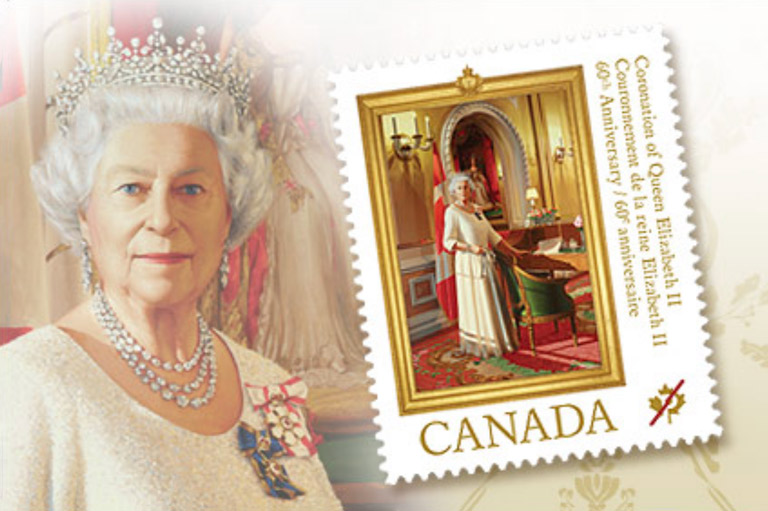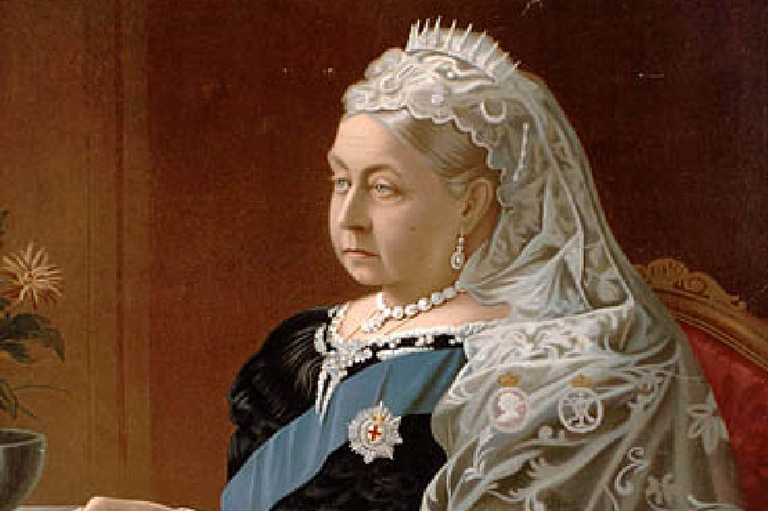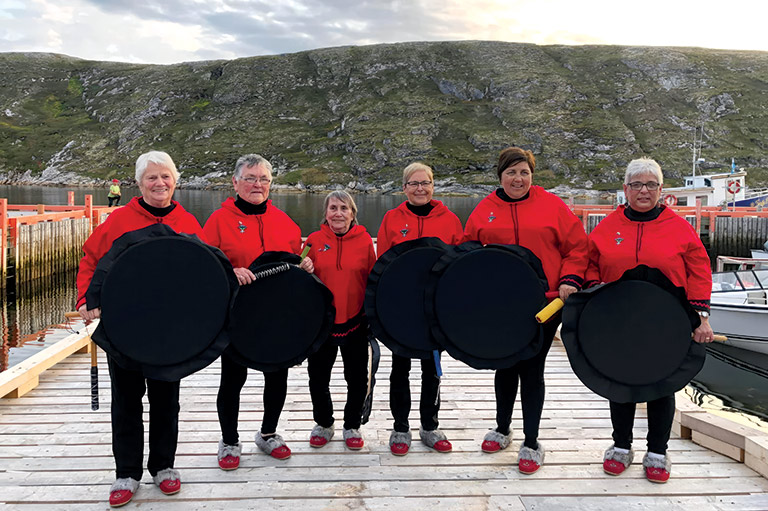Remembering Elizabeth II, Queen of Canada
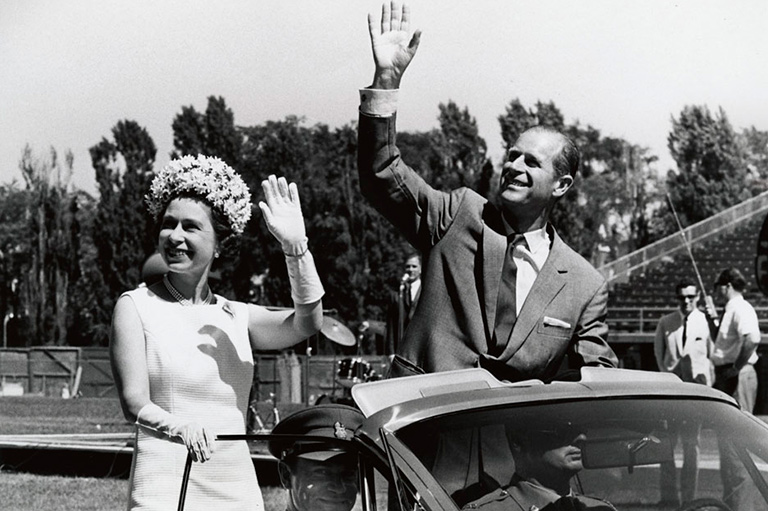
After an unprecedented reign over the United Kingdom, Canada, and thirteen other countries worldwide, Queen Elizabeth II died at Balmoral Castle in Scotland on September 8. The Queen was surrounded by her family including heir to the throne Prince Charles and his wife Camilla; the Queen’s other sons, Prince Andrew and Prince Edward; her daughter Princess Anne; and her grandson Prince William. Prince Harry was on his way. She was predeceased by her husband Prince Philip, Duke of Edinburgh.
Crowds of mourners gathered outside the gates of Balmoral and at Buckingham Palace in London. Leaders from around the world sent their condolences. Canadian Prime Minister Justin Trudeau wrote on Twitter: "It was with the heaviest of hearts that we learned of the passing of Canada’s longest-reigning Sovereign, Her Majesty Queen Elizabeth II. She was a constant presence in our lives – and her service to Canadians will forever remain an important part of our country’s history."
"As we look back at her life and her reign that spanned so many decades, Canadians will always remember and cherish Her Majesty’s wisdom, compassion, and warmth," he added.

On June 2, 1953, Queen Elizabeth II was crowned in Westminster Abbey in a coronation service little changed from the one written more than one thousand years ago. For the new Queen, however, there were two key changes from centuries-old tradition. The first was the expanded audience for the enthronement. The Queen’s father, King George VI, had given permission for the nascent BBC to film the procession to the abbey for his own coronation in 1937, but Elizabeth II allowed the cameras into the abbey itself to film all of the ceremony except for the anointment. The coronation became the first trans-Atlantic television broadcast as footage was flown from Britain to Canada to allow Canadians to watch the ceremony on the day it took place. At the same time, the expanded availability of air travel meant that thousands of Canadians attended the coronation celebration at Canada House, the building that houses the Canadian High Commission to the United Kingdom, and at other venues surrounding the event.
The second difference between the Queen’s coronation and earlier ceremonies was the nature of the oath. George VI was the first monarch to tour Canada as sovereign in 1939 and he became head of the Commonwealth in 1949. In 1947, Eugene Marquis, the Liberal member of Parliament for Kamouraska, Quebec, stated in the House of Commons that the monarch should no longer be known formally as the king of “Dominions Beyond the Seas” but “King of Canada” and his proposal was embraced by the Canadian Department of External Affairs.
In 1953, the Archbishop of Canterbury administered a new coronation oath to Elizabeth II, “Will you solemnly promise and swear to govern the Peoples of the United Kingdom of Great Britain and Northern Ireland, Canada, Australia, New Zealand, the Union of South Africa, Pakistan, and Ceylon [now Sri Lanka], and of your Possessions and the other Territories to any of them belonging or pertaining, according to their respective laws and customs?” Elizabeth II was the first monarch to spend her entire reign as Head of the Commonwealth of equal nations instead of the British Empire and self-governing dominions.
For Queen Elizabeth II, succeeding to the throne meant giving up the comparatively private life that she enjoyed early in her marriage while Philip pursued his naval career.
The extensive Commonwealth tours in the initial years of her reign sometimes separated the Queen from her children for months at a time. The red boxes of state documents were delivered every day except Christmas and Easter regardless of where the Queen was residing. Throughout her reign, she treated her royal duties with unfailing diligence, prioritizing her public duties over her personal life.
In 1947, at the age of twenty-one, the future Queen Elizabeth II declared in a radio broadcast in South Africa on her first Commonwealth tour, “I declare before you all that my whole life whether it be long or short shall be devoted to your service and the service of our great imperial family to which we all belong.”
The Queen had been crowned Queen of Canada and she would develop a personal relationship with Canadians unmatched by any of her predecessors.

Early Life
The new Queen had been well known to Canadians since her birth on April 21, 1926, at 17 Bruton Street, the London home of her maternal grandparents, Claude and Cecilia Bowes-Lyon, the Earl and Countess of Strathmore and Kinghorne. The new princess was named Elizabeth Alexandra Mary for her mother, great-grandmother and grandmother respectively. Her parents were Lady Elizabeth Bowes-Lyon, a Scottish aristocrat, and Prince Albert, Duke of York, the second son of King George V. The Toronto Globe announced on its front page “Daughter is born to the Duchess of York” while other Canadian newspapers emphasized how her doting parents, grandparents, and other family members showered the infant princess with presents and baby clothes. Elizabeth and her sister, Princess Margaret (later Countess of Snowdon), grew up in the public eye, particularly after the abdication of their uncle, Edward VIII in 1936, and the accession of their father that same year. Prince Albert chose one of his middle names, George, when he ascended to the throne as King George VI, to symbolize continity with the reign of his father King George V.
In 1939, George VI and his wife — now Queen Elizabeth, the Queen consort — travelled across Canada by train, becoming the first reigning royal couple to undertake a Canadian tour. The tour had originally been planned to showcase King George VI’s role as sovereign of a distinct Canadian Crown following the introduction of the Statute of Westminster. With war looming in Europe, however, this trip assumed new political significance, as it was intended to swell pro-British sentiment. The royal children remained in Britain due to the tour’s rigorous schedule of public engagements. As the royal train travelled along the shore of Lake Superior, Queen Elizabeth wrote to her daughter, the future Queen Elizabeth II, “Canada is a very beautiful country — I hope that you will see it some day.”
During the Second World War, there was speculation that the royal family might move to Canada for the duration of the hostilities. In 1940 the Canadian government under Prime Minister William Lyon Mackenzie King acquired Hatley Castle (now part of Royal Roads University, outside of Victoria), possibly with the intention of offering it as a residence for the royal family in the event of a German invasion of England. But the royal family was determined to remain in Britain and the future Queen Elizabeth II served as a mechanic in the Auxiliary Territorial Service, the women’s branch of the British Army in 1945.
After the war, Princess Elizabeth married Lieutenant Philip Mountbatten on November 20, 1947. Though he was born Prince Philip of Greece and Denmark, Philip became a British citizen and renounced his place in the succession to the Greek and Danish thrones in order to become the Duke of Edinburgh and husband of the future Queen. (He had been sixth in line for the Greek throne, and was an even more distant contender for the throne of Denmark.) Elizabeth and Philip had four children — Prince Charles (1948), Princess Anne (1950), Prince Andrew (1960), and Prince Edward (1964) — eight grandchildren, and twelve great-grandchildren.
Royal Tours
Princess Elizabeth made her first visit to Canada in 1951, taking the place of her father who was being treated for lung cancer. Like William and Catherine (the Duke and Duchess of Cambridge), Princess Elizabeth and Prince Philip, Duke of Edinburgh, seemed to represent a modern monarchy that connected to younger people. They arrived in a plane instead of a ship and Philip wore a white cowboy hat at the Calgary Stampede. They received a warm welcome throughout the tour. A photo of the young royal couple square dancing at Rideau Hall in Ottawa was made into a popular Canadian Christmas card. There were spontaneous moments, such as the time when the young couple experienced a late autumn snowfall and built a snowman nicknamed Mr. Churchill. In contrast to subsequent visits, Philip overshadowed Elizabeth, as the Princess appeared reserved and serious compared to her gregarious husband.

In 1957, she returned to Canada, this time as Queen Elizabeth II, and became the first sovereign to open Canada’s Parliament in person. Along with Prince Philip, she visited all the provinces and territories in 1959, the longest royal tour in Canadian history. The tour prompted one of the earliest debates about Canada and the monarchy, when CBC journalist Joyce Davidson commented, “Like most Canadians, I am indifferent to the visit of the Queen.” She added that Canadians were “annoyed” at still being “dependent” on a foreign monarch. The comments provoked a firestorm of controversy, and Toronto Mayor Nathan Phillips countered that Davidson did not speak for all Canadians. Discussion and debate regarding the place of the monarchy in Canada became a fixture of subsequent royal tours.
In 1964, while touring Canada during Quebec’s Quiet Revolution, the Queen faced protestors in Quebec City who chanted, “Elizabeth, stay at home.” In response, police attacked protestors and journalists with billy clubs, and Quebec journalists dubbed October 10, 1964, le samedi de la matraque, or Truncheon Saturday. Unflustered, the fluently bilingual Queen stated in an address to the Quebec legislature that she was pleased that there was a place in the Commonwealth where she could express herself in French. The monarchy remained comparatively unpopular in Quebec and Prince Charles faced protestors during a visit to Montreal in 2009.
The 1970s saw the Queen and her family visiting Canada more frequently, at the same time that royal iconography was becoming less prominent in the Canadian government. In 1970, the Queen, Philip, Charles, and Anne toured remote communities along the Arctic Circle to mark the hundredth anniversary of the Northwest Territories and to implicitly affirm Canadian sovereignty over the Arctic. In 1973, she delivered a speech at Toronto’s Royal York Hotel praising Canada’s multicultural society and stating: “It is as Queen of Canada that I am here — Queen of Canada and of all Canadians, not just of one or two ancestral strains.”
In the late 1970s, the Queen’s second son, Prince Andrew, briefly attended Lakefield College School near Peterborough, Ontario, and the Queen undertook frequent royal tours. She opened the 1976 Montreal Olympics, where her daughter Anne competed in equestrian events. In 1977, she marked her silver jubilee with a six-day tour of Canada. In 1978, she opened the Commonwealth Games in Edmonton, where she remarked, “I am getting to know our country rather well.”
Perhaps the Queen’s most historically and politically significant visit to Canada occurred in 1982, when she participated in the patriation of Canada’s Constitution. In 1984 she marked the bicentennial of the creation of the colony (now province) of New Brunswick and the arrival of British loyalists to the region that is now Ontario. And in 1990 she met in Calgary with members of Treaty Seven First Nations — a treaty signed in 1877 with Elizabeth’s great-great-grandmother, Queen Victoria. By that time, however, her children and their spouses were beginning to take centre stage in the public eye. Charles and Diana, the Prince and Princess of Wales, attracted massive crowds that included spectators previously indifferent to the royal family when they toured Canada in 1983.
The Queen toured Canada in honour of her Golden Jubilee in 2002, dropping the puck at a Vancouver Canucks game. She visited Canada for the last time in 2010, presiding over the Canada Day celebrations on Parliament Hill. Like the Queen’s Golden Jubilee tour in 2002, the 2010 tour celebrated the Queen’s decades of public service. The tour began a period of revived media visibility for the monarchy, especially after Prince William, the Queen’s grandson and second in line to the throne, married Catherine Middleton in 2011. The wedding was followed quickly by the birth of the couple’s first child, Prince George, in 2013. The births of Princess Charlotte and Prince Louis followed in 2015 and 2018 respectively. Meanwhile, the Queen celebrated her Diamond Jubilee in 2012 and her Platinum Jubilee in 2022.
With 7 uniquely curated newsletters to choose from, we have something for everyone.

Political Role
In 1952, Elizabeth II inherited a constitutional monarchy, a system of government which had evolved from the seventeenth century. In 1689, King James II, a Roman Catholic who favoured the divine right of kings, was dethroned by his daughter Mary and her Dutch husband, William of Orange. Following their accession to the throne, King William III and Queen Mary II were asked by the British Parliament to accept a Bill of Rights that ensured that they would uphold the law and accept the legal supremacy of Parliament. This “Glorious Revolution” began England’s transformation from an absolute to a constitutional monarchy, in which the monarch’s power was defined and limited for the first time.
Canada inherited the constitutional monarchy with Confederation in 1867. The Balfour Declaration of 1926, stating the Britain and her dominions were constitutionally equal, gave Canada control over its own foreign policy. A few years later, the Statute of Westminster of 1931 removed the British Parliament’s ability to legislate for Canada.
According to the letters patent of 1947, the Governor General exercises the prerogatives of the sovereign, including the role of granting royal assent to legislation and the ability to appoint and suspend judges, commissioners, and ministers. In modern practice, however, royal assent is almost always an automatic process as appointments are made by the prime minister, and the role of the Governor General, like that of the Queen, is almost entirely ceremonial and symbolic. The monarch, represented by the Governor General, however, holds the reserve powers in the event of a constitutional crisis, such as a Prime Minister refusing to leave office having lost the confidence of parliament. The Queen exercised the role of Canada’s Head of State in person in 1957 when she gave the throne speech in Parliament, and in 1976 when she opened the Summer Olympic Games in Montreal.
Queen Elizabeth has taken her role as an impartial constitutional monarch seriously, remaining above politics and taking care not to publicly criticize her prime ministers or their policies. Nevertheless, there have been hints of her political views over the decades. Her speech at the 2011 Commonwealth Heads of Government meeting in Perth, Australia, mentioning the important contribution of women in society was widely interpreted by the public as evidence of her personal support for introducing gender neutral succession reform, which came into force in the United Kingdom and Commonwealth in 2015. The Queen’s comment that Scottish voters should think “very carefully” about the referendum vote appeared to be a caution against the breakup of the United Kingdom.
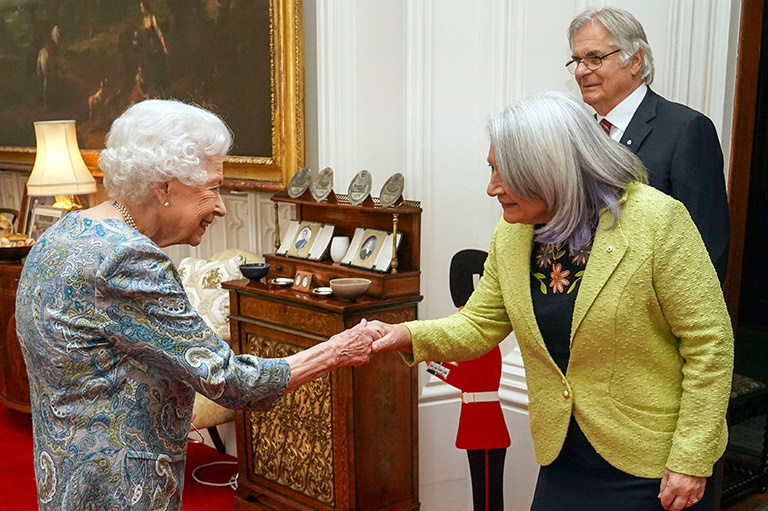
In Canada, the Queen also had a distinct role as the embodiment of the Crown in Canada’s relationship with First Nations people. The Royal Proclamation of 1763, enshrined in the Constitution Act of 1982, upheld First Nations’ land rights. In many of her speeches, the Queen emphasized a personal relationship between her family and generations of First Peoples. When she laid the foundation stone for First Nations University of Canada in Regina in 2005, she said: “This stone was taken from the grounds of Balmoral Castle, in the Highlands of Scotland, a place dear to my great-great grandmother Queen Victoria. It symbolizes the foundation of the rights of First Nations peoples reflected in the treaties signed with the Crown during her reign.”
The Queen intended for the stone to “serve as a reminder of the special relationship between the sovereign and all First Nations peoples.” However, the relationship of First Nations peoples to the Crown has become more contentious in recent years. In 2021, demonstrators at a rally for the victims and survivors of residential schools tore down statues of Queen Victoria and Queen Elizabeth II outside of the Manitoba Legislature. Recent royal tours have focused on reconciliation with Indigenous peoples. In 2022, Prince Charles acknowledged the suffering caused by the residential school system during his platinum jubilee tour of Canada.
Naturalized citizens of Canada are required to take an Oath of Citizenship that states, “I swear (or affirm) that I will be faithful and bear true allegiance to Her Majesty Queen Elizabeth II, Queen of Canada, Her Heirs and Successors, and that I will faithfully observe the laws of Canada and fulfil my duties as a Canadian citizen.”
This oath has occasionally become a focus of public debate when new Canadians from birthplaces as diverse as Jamaica (another Commonwealth realm) and Ireland (which achieved independence from the United Kingdom after a violent struggle) objected to swearing allegiance to the Queen. Although many critics of the monarchy nevertheless respected the Queen as a public figure and stateswoman, her passing raises the question of whether Canada should retain a foreign-born head of state, and whether Canadian citizenship should require allegiance to a monarch who lives in Great Britain.

Save as much as 40% off the cover price! 4 issues per year as low as $29.95. Available in print and digital. Tariff-exempt!
Public Image
The Queen’s decision to allow the coronation to be televised began a decades-long process of presenting the Queen’s image in a tightly controlled fashion to the public. The monarch was one of the most recognizable public figures in the world with her face appearing on stamps, coins, and commemorative items. At the same time, her opinions on current events were unknown, which made the monarch a favourite subject of novels, plays, films, and television series that imagined the conversations that might have taken place behind palace walls. The most famous of these is the Netflix series The Crown.
The degree to which cameras and journalists should be allowed into the royal family’s private life was a subject of debate over the course of the Queen’s reign. In 1969, BBC cameras were permitted to follow the Queen for a documentary entitled Royal Family, which gave most viewers their first glimpse of members of the royal family speaking outside of an official occasion. With the exception of brief excerpts, the documentary was not shown again on television, perhaps due to concerns by advisors that the royal family appeared too “ordinary,” but the film can be seen on YouTube.

In Canada the Queen projected a slightly different image than in the United Kingdom. Since the nineteenth century, Canadians have expected members of the royal family to behave with some degree of informality. Canadian tours often featured more casual, though still carefully choreographed moments, such as the monarch riding the monorail at Expo 67 and dropping a ceremonial puck during an NHL Game in Vancouver during her 2002 Golden Jubilee tour.
In the 1980s and 1990s, the private lives and misbehaviours of the Queen’s children, and, later, their spouses, were scrutinized and sensationalized by the media. A series of scandals and marital infidelities among the younger generation of royals culminated in the Queen’s “annus horribilis” of 1992. That year, Charles and Diana’s faltering marriage ended in separation, while Diana published a tell-all book the revealed Charles’s affair with Camilla Parker Bowles, among other private details. Charles’s reputation suffered and the public expressed doubts about whether he could become a respected monarch. Meanwhile, the Queen’s daughter Anne, Princess Royal, divorced her husband Captain Mark Phillips and the Queen’s second son, Prince Andrew, separated from his wife Sarah Ferguson, whose various romantic flings received extensive tabloid coverage.
Despite the scandals brought to light by the paparazzi and their long-range camera lenses, the Queen seized the opportunity to use emerging media platforms to broadcast royal engagements and philanthropy to a wider audience. The Queen referenced the Internet in a 1997 speech and an official website for the royal family soon followed. They royal family now has accounts on Facebook, Twitter, Instagram, and YouTube that routinely showcase their tours and events.
In the sixth decade of Queen Elizabeth’s reign, the royal family once again became embroiled in scandal and controversy. In 2020, Prince Charles’s second son, Prince Harry, the Duke of Sussex, relinquished his official role in the family and moved to Canada then California with his wife, Meghan (nee Markle), Duchess of Sussex, and their son Archie. Markle, who lived in Toronto for five years while filming the TV series Suits, complained of the intrusiveness of the British press. After reaching an agreement with the Queen not to use the title “Royal Highness,” Harry and Markle shut down their short-lived Sussex Royal charitable foundation and founded a new foundation, Archewell.
In 2021, the couple held an explosive television interview with Oprah Winfrey in which they alleged that racism had made Markle feel unwelcome within the royal family. The same year they signed a multi-million dollar content-creation deal with Netflix. Rumours of a behind-the-scenes reality show about their lives, and the upcoming publication of Harry’s autobiography, have raised speculation over whether the Sussexes will expose any further insider knowledge of the House of Windsor.
Meanwhile the Queen’s second son, Prince Andrew, faced allegations of sexual assault connected to his friendship with convicted sex offender Jeffrey Epstein. Andrew was served with a lawsuit in August 2021 by one of Epstein’s victims, Virginia Giuffre, who accused the prince of raping her when she was seventeen. After a disastrous interview in 2019, Andrew’s charitable patronages distanced themselves from him. The Queen stripped Andrew of the title “His Royal Highness,” and he lost his military titles, royal patronages, and public duties. Andrew settled the lawsuit with Guiffre in February 2022, for an undisclosed amount.
The heir to the throne, seventy-four-year-old Prince Charles, married his former mistress Camilla Parker Bowles in 2005. As Duchess of Cornwall, she gradually became a respected member of the royal family and the Queen expressed a wish at the time of her Platinum Jubilee that Camilla would one day be known as queen consort. Charles and Camilla were well received when they visited Canada in 2022. However Charles’s charity, The Prince’s Foundation, was investigated by Scotland Yard in 2022 over allegations that its chief executive promised to secure a knighthood and British citizenship for a Saudi national in exchange for a donation. The prince claimed no knowledge of the affair.
The Queen remained personally unimplicated in any of the scandals that swirled about her. On the contrary, she was seen by the British public as a noble and dignified figure when she attended the funeral of her beloved husband, Prince Philip, alone during the COVID-19 pandemic in April 2021.
Legacy
The name of Queen Elizabeth II’s great-great-grandmother, Queen Victoria, became synonymous with the second half of the nineteenth century, which is still known as the Victorian era. Queen Victoria’s birthday remains a public holiday in English Canada to the present day, honouring her role as a Mother of Confederation. When Elizabeth II was crowned in 1953, there was talk of a new Elizabethan age, although this description of her reign did not last long beyond her coronation as the Suez crisis of 1956 symbolized Britain’s declining role on the world stage.
The Queen saw few parallels between herself and the Tudor Queen Elizabeth I, stating in her 1953 Christmas broadcast,“I do not myself feel at all like my great Tudor forebear who was blessed with neither husband nor children, who ruled as a despot and was never able to leave her native shores.”
While Elizabeth I ruled alone, and Victoria spent the last forty years of her reign as “the widow of Windsor,” Elizabeth II enjoyed a seventy-three-year marriage to the Duke of Edinburgh and became the matriarch of a multigenerational royal family.
Elizabeth I never left England and Victoria did not venture beyond Europe but Elizabeth II became the most well-travelled monarch in history, paying official visits to more than 120 countries.
In 2022, the ninety-six-year-old Queen celebrated her Platinum Jubilee, marking seventy years on the throne. In the United Kingdom, the Jubilee was a massive four-day extravaganza attended by millions of people, though the Queen herself was only able to appear at the beginning and end of the celebrations Official celebrations began with a traditional Trooping the Colour parade; continued with a thanksgiving service at St. Paul’s Cathedral, a derby at Epsom Downs, and an invitation-only Platinum Party at the Palace broadcast on the BBC; and ended with an enormous outdoor pageant that featured a military parade, a three-hundred-strong peleton of cyclists, a phalanx of vintage cars, singers, celebrities, life-sized puppets, Bollywood dancers, and the 260-year-old Gold State Coach with a hologram of a young Queen Elizabeth seemingly riding inside it. As the pageant arrived in front of Buckinham Palace, the Queen made an appearance on her balcony flanked by members of the royal family, and the ecstatic crowd burst into a gigantic chorus of God Save the Queen. Thousands of other Jubilee events took place in communities across the United Kingdom.
In Canada, Prince Charles and the Duchess of Cornwall made a three-day Jubilee tour, where they were several times confronted with Britain’s colonial legacy toward Indigenous people, including residential school survivors. RoseAnne Archibald, national chief of the Assembly of First Nations, asked the royal couple for a formal apology from the Queen for “the Crown’s ongoing failure to fulfill its treaty agreements,” but the Prince did not comment on the request. Meanwhile, Governor General Mary Simon, who is Inuk, congratulated the Queen in a formal address and remarked: “Growing up in Northern Quebec, my grandmother would show us pictures of The Queen. Her Majesty was revered in the Arctic, since the relationship between the Crown and Indigenous peoples is considered sacred.”
The record-breaking length of Elizabeth’s reign, exceeding Victoria’s sixty-three-year time on the throne, has allowed the Queen to be present through an unprecedented period of social, cultural and political change. Her commitment to the Commonwealth and her role as Queen of its individual realms remained constant throughout her reign. She will be remembered by many as a dignified stateswoman who provided continuity during many decades of international turmoil.
Nevertheless, the royal tours to Canada that took place at various times during her reign exposed the growing ambivalence of many citizens — particularly those of Indigenous and French-Canadian origin — towards maintaining Canada’s ties to the Crown. Ultimately it will be up to the Canadian people to decide whether Elizabeth’s legacy will include a role for the monarchy in Canada in the twenty-first century.
At Canada’s History, we highlight our nation’s past by telling stories that illuminate the people, places, and events that unite us as Canadians, while understanding that diverse past experiences can shape multiple perceptions of our history.
Canada’s History is a registered charity. Generous contributions from readers like you help us explore and celebrate Canada’s diverse stories and make them accessible to all through our free online content.
Please donate to Canada’s History today. Thank you!
Themes associated with this article
Advertisement
You might also like...

Canada’s History Archive, featuring The Beaver, is now available for your browsing and searching pleasure!



